
What are the best and healthy ways to reduce office stress and frustration?

What are the best and healthy ways to reduce office stress and frustration? Reduce office tension and frustration with the best know techniques accustomed by prosperous men.
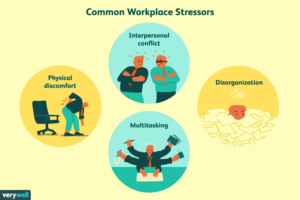
Everyone around the world gets frustrated from time to time, especially in the office environment with high-pressure. Many people hide or suppress their emotions, which isn’t healthy. It could ultimately cause your emotions to boil over spectacularly, ruining your reputation within your organisation. You must be able to release frustration, especially at work.
Instead of letting your emotions control you, it’s essential to manage and healthily release them. Most people in the workspace think about time management when trying to achieve a healthy work-life balance. However, there is also an emotional component that you should address when considering how work influences your overall wellness, productivity, and quality of life.
Here are a few healthy ways to deal with your emotions on those days you feel overwhelmed with frustration.
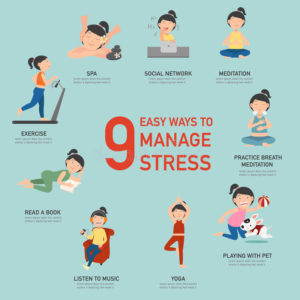
Healthy ways reduce office stress and frustration

- Face Your Frustration
The first and foremost step in releasing anger or frustration is to acknowledge it and observe it. The root cause of your frustration isn’t going to disappear magically, and it’s essential to face your frustration so that you can do something about it. Understanding how and why you get anger or frustration can help you deal with the emotion and even prevent it in some cases.
Thinking critically about an emotion, you are probably not proud of is difficult. But analysing the situations that cause you frustration is key to controlling your emotions in a healthy way over the long term. And always remember to take a moment to collect yourself before you respond to a frustrating situation. It will hold you from saying something you will regret later.
- Give Yourself a Break
We are all hard on ourselves. We think that we need to become perfect, even-tempered robots who never get frustrated, angry, or sad at work. Can you imagine how boring that could be?
Give yourself a break. You are not perfect, and neither are your colleagues. Don’t beat yourself up for getting frustrated sometimes. It’s just human nature. Just learn how to prevent it when you can and release it in a healthy way when you can’t. You will feel much better than if you expect perfection from yourself.
- Tend to Your Mind, Body, and Soul
You may consider self-care as something that happens outside the office premise, but that isn’t the case. It’s a good idea to have some go-to practices you can use to overcome stress and calm down when you feel frustrated at work.
Meditation, breathing and mindfulness exercises, and desk yoga are all great options for in-office wellness. You don’t have to spend hours in a quiet room to tend to your mind, body, and soul. Even just a few moments of stretches or deep breathing can help you calm down, get some perspective, and release tension.
- Get Comfortable
How is your desk set up at the office? Do you have an uncomfortable chair or a desk that isn’t quite the right height? If so, you may be physically uncomfortable, which doesn’t help when you’re feeling frustrated. If you can, try upgrading to a more comfortable chair. Invest in some noise-cancelling headphones if the ambient noises in the environment are adding to your frustration.
- Manage Your Workload
Going above and beyond may seem like a great idea at the moment, but in reality, it’s not good for anyone involved. If you take on more than you should, you may start to feel bitter, resentful, and frustrated, or at least overwhelmed. That added stress can make you feel frustrated and make you less productive overall.
You might think that taking on extra work is a great way to gain your boss’s approval. But if you burn yourself out and become frustrated consistently, you’re likely to have trouble managing your workload, and your emotions could boil over. Learn the power of saying “no” at the right time, and you will be able to manage your emotions more effectively.
You Need to Let the Frustration Out!
It’s important to reduce office stress and frustration as it occurs. Failure to do so could drive to changes in your mood and attitude that might impact your job performance and well-being. Letting frustration and resentment build can also lead to unhealthy habits such as gambling, alcohol and drug abuse or other dangerous behaviours.
Frustration is an alluring emotion that’s fuelled by entitlement or self-righteousness. Whether or you are justified in your frustration in any given situation or not, it’s crucial to deal with the emotion and let it out in a proper way. If you don’t, you’re only hurting yourself!


Here are the quick tips on how to handle a remote workforce during coronavirus outbreak
Managing a remote workforce during coronavirus outbreak is quite a task to be taken on the event of the coronavirus pandemic.
Managing a remote workforce during coronavirus outbreak with the best methods can effectively improve better productivity in a concern.

The novel coronavirus is spreading abundantly after each passing day. It leads many companies to ask their employees to work from home. It is an effort to slow down the spreading and preserve the health and safety of their people. This change created a new set of challenges for managers as they need to support and stays connected with their new remote workforce. If you are also one among those managers, here are a few tips to help you.

How to effectively manage a remote workforce during coronavirus outbreak?

- Establish a remote leadership team
Shifting an entire division or a company can trigger a shockwave of change. So, for mitigating this, you can start evaluating the current managers and rally a team of experts who have experience in handling remote workforce. These people should be efficient to communicate nuances and serve as resources to the employees who will inevitably have doubts or questions.
The core part of this team’s role will be to document challenges in real-time. They should transparently prioritize those challenges and need to assign DRIs (directly responsible individuals) to find the right solutions.
Executive assistants should also take on a more important role in the transition. They can become documentarians in meetings and assist in internal communications.
- Create a “source of truth” handbook to hold your employees in the loop
It can be rudimentary to start but will serve as a single source of truth for the pressing questions. You’ll need to communicate this widely in the company and update it continually with DRIs for common questions or issues around tools and access.
One of the most sizable hurdles when going remote is keeping everyone in the loop in an efficient way. Put concerted effort around systematically documenting significant process changes in a central place to reduce confusion and dysfunction.
- Create a formal (and informal) communication plan
Depending on the size of the team, consider creating an always-on video conference room per team. Here team members can linger, or come and go as they please. This simulation helps acclimation. It enables team members to embrace the shift to remote in a less jarring way. It also shows intentionality around informal communication, an essential element that happens spontaneously in an office and needs a sudden replacement in a remote setting.
Whatever your current view on transparency is, leaders should not go back during this time. It’s crucial to maintain perspective through this shift. Everyone reacts to working remotely differently, and not all homes are ideal workspaces. It can feel jarring, and team members will expect frequent updates as leaders iterate on their communication plan in real-time.
- Minimize your tool stack
While functioning remotely, your firm should strip the tool stack down to a minimum. You can use Google Docs, a company-wide chat tool and Zoom or another video conferencing platform to start the remote journey. Your team may need access to internal systems through a VPN. Then, make sure that everyone has easy access, and instructions on usage are clear.
Working well from a remote place requires writing things down. For firms who do not have an existing culture of documentation, this will prove to be the most challenging shift. So, you should aim to funnel communication into as few places as possible. It will reduce silos and fragmentation. You will want to proactively solve for mass confusion when it comes to finding things. It includes various policies, protocols, outreach mechanisms, messaging, and so on.
- Drive cultural change
Human beings are resistant to change naturally, especially changes that are formed during the time of uncertainty or crisis. Leaders need to meet this reality head-on. An all-hands approach to recognize the new reality is essential to empower everyone to add their contribution to the success of remote working.
Particularly it is vital for firms with strong “in-office cultures,” to understand that the remote transition is a process. It is not a binary switch to get flipped. Leaders are responsible for embracing the iteration. They need to be open about what is and are not working, and message this to all employees.
Managing a remote firm is much like managing any company. It comes down to trust, communication, and wide support of shared goals. The power of going fully remote, long-term can benefit your company a lot. It not only can you reduce overhead costs, but you can dramatically expand your talent pool since candidates’ physical proximity will no longer limit you to your facilities.
It’s great for the team member. They save the time they spend on commuting to the office. And most of all, they get work flexibility. If the kids are sick, they are already working from home. They are able to be there for them. And it shows up in employee retention.
The work world has changed in the last couple of weeks, and the firms are navigating new challenges. One of them is how to adapt and handle remote work. Some firms are offering limited work from home for the first time. Some other companies have gone 100% remote for the first time. It seems like nearly everyone is embracing or at least testing the future of work.
Flexible and remote work arrangements are becoming a powerful tool for most companies. It attracts and retains talent and strategic levers with which companies can control costs.
So, if you are not offering remote work options now, it’s an excellent time to consider them. If you are offering them only until the coronavirus outbreak get brought under control, it’s time to consider making them permanent. And if your firm does have to make a sudden shift for any reason, it helps to have processes in place to keep your things on track.


How to become more productive when you work from home during coronavirus epidemic?
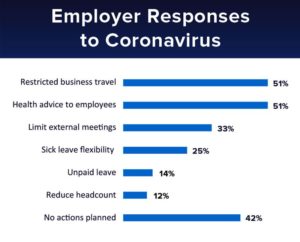
How to become more productive when you work from home during coronavirus epidemic? Fruitful ways to stay productive when working from home during coronavirus epidemic.
Work from home is an option most businesses have started adopting in the ongoing bid to curb the coronavirus outbreak. There are about 115 cases confirmed currently and has been one death in the UK.
Google, JP Morgan and Twitter are some of the large companies released Covid-19 contingency plans to UK-based staff, which include compulsory working from home.
It is believed that keeping employees further apart from each other can reduce the chance of group spread. It also avoids the opportunity for the virus to be caught during a commute or in communal office spaces.
Although the government hasn’t yet advised all businesses to follow suit and adopt remote working, Prime Minister Boris Johnson in his speech on Tuesday has said enforced home working could be an option if the situation worsens.
It isn’t an option for some workers. But what is the best way to maximise productivity for those who might find themselves sent home in the coming weeks? How will they maintain good physical and mental health, and not spend all day in the pyjamas when working from home? Know it below.

What are the perks of work from home during coronavirus epidemic?
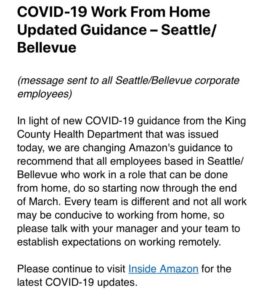
- How to distinguish between work and home mode
One of the significant perks of working from home is slowly moving from bed to the sofa five minutes before you start. It can also be your biggest challenge.
Never forget that you are there to work. So, set yourself up in the right manner. Wake up on time, get dressed and brush your teeth at the start of the day instead of sitting in your pyjamas for eight long hours. So, Switch from home to work mode.
You can do something physically to make yourself ready for the day. Maybe it’s walking around the block, making a special tea, or lighting a candle at your desk. No matter what it is but do it without fail to create a strong association in your mind.
- Be realistic about what you can achieve
Working from home in a wide, open day can feel full of possibilities. One hundred forty-five things on the to-do list? No problem! Don’t fall into the trap of getting over-ambitious. Instead, be realistic and then possibly achieve more than you set out to. Then, you feel satisfied, rather than feeling disappointed you didn’t do everything.
Choose three to five things to do and aim to get the majority done before lunch break. Most people slow down in the mid-afternoon and having a lot in the list will give you the momentum to power through.
- Work in short bursts
When you are in the office, your day is get split by everything from meetings to lunch breaks and even toilet breaks. But when you sat at home on your own with no face-to-face interaction planned it can be easy to work for long, unbroken periods.
When we are in the office, our day is usually broken up with meetings. Although it can be frustrating, they divide the day up and create natural chunks of time. In contrast, the days at home can be very unstructured.
Impose structure on yourself to be more productive. For instance, working in 45-60 minute chunks of focused work followed by a short break. It can be an effective way to break the day up and maintain your concentration levels.
- Don’t forget to take breaks
It can be extremely challenging to tear yourself away from your laptop if you are worried people might think you are slacking off. But that doesn’t mean you should not take breaks. Just because you are feeling comfy at home, it doesn’t mean you don’t need a proper break.
Leave your desk for lunch and take benefit of being at home. You can walk the dog and blow the cobwebs away for half an hour in the afternoon. Then, you will return feeling refreshed and more productive for the rest of the day.
It also includes ensuring you make time to make proper meals and drink water regularly, instead of snacking continuously throughout the day and then crashing in a sugar slump at 3 pm.
- Manage distractions
Being in the office atmosphere gives us a limited number of ways to get distracted. But when you start working at home, you may easily get distracted.
There are plenty of potential distractions when we work from home. So, proactively handle things, which might interrupt your focus.
Keep them limited to do in the short breaks in between the chunks of focused work. As a change of scene, we need to give our brain a break. And it is the perfect time to put a load of washing on or empty the dishwasher.
- Be sociable
Unless you are self-isolating, working from home should not mean that you will not leave the house at all or don’t see your acquaintance for two weeks. Ensure you still keep up social interaction.
If you are a person, who will miss your colleagues when you work from home, build opportunities for socialising into your day. Try to call your colleagues rather than constantly email or Slack messaging.
If you really struggle to apply yourself, try virtual ‘body doubling’. Connect with a colleague via a Skype video call but both work ‘live’ on your project rather than chatting.

What are the best ways to celebrate international women’s day?

What are the best ways to celebrate international women’s day? The best way to have a creative motivational women’s day in the workplace.
The world is marching towards a progressive, technologically advanced and socially diverse community. And the time has come to do everything possible for greater women’s involvement and participation both at the workplace and in everyday life.
As the International women’s day is around the corner, most people look out for creative women’s day programs in our workplaces. So, here are some useful ideas to mark your day in a creative, positive, and thoughtful manner.
We usually celebrate this day by attending cultural performances, sending roses to each other, or sending sweet text messages. All these things are some of the ways of remembering this day. But how about we plan something different this time and be a little unpredictable?
The theme for 2020 International Women’s Day is #EachForEqual. It focuses on how each one of us can be a participant in the march towards equality. So, what activities can organisation conduct to highlight this aspect while celebrating this year’s women’s day programs? Know it below.
Activities to celebrate Women’s Day

- Create an IWD 2020 pledge wall
Engage your workers and encourage them to commit an action to forge a more gender-equal world by creating a pledge wall. It is an activity that also works for organisations that have implemented team segregation as part of the business continuity planning. Just leave the wall as long as it takes for a full team rotation (e.g. for the month of March). Consider the tips given below to create your own pledge wall:
Step 1: Select a wall in the workspace.
Step 2: Set the context. Explain what #EachforEqual means and why a gender-equal world is essential.
Step 3: Give a call to action. You can use the questions like “What action can I take to help forge a more gender-equal world?”
Step 4: Get your employees to write their name on the cards. Then, write a specific and tangible action they want to take to help forge a more gender-equal world. For example, “I will mentor a woman and assist her in building her networks – #EachforEqual. “
Step 5: Stick all the cards on the designated wall.
Step 6: When you are taking down the wall, encourage employees to pick up their card and keep it with them. It will be an everyday reminder of their promise for action.
- Organise TED-style talks by women members in your office
Women have moved ahead to great leadership positions around the world. There are several instances where women have bravely faced every challenge of society. They raised their voices on gender diversity, domestic violence, self-esteem, girl power, and a lot more issues that touch a nerve. Just listening to them for a few moments creates a circle of positive energy around us. Such inspiring talks and real-life stories can provide lots of energy and motivation that remain with us long after the talks are over.
- Company’s focus on gender diversity
A key highlight of women’s day programs can be a motivational talk organised by women employees of your company who have influenced in contributing to the growth and reach of the organisation. There can be presentations showcasing the company’s achievements in bridging the gender gap in the workplace. It can also be an occasion to highlight the initiatives the organisation has taken to increase women’s involvement in the team.
You can also invite other keynote speakers from the industry to share their opinion on the current statistics in gender diversity. On this special day, the company’s website can run stories of their women leaders. Such inspirational stories can create a very strong impression on the minds of everyone about how change can happen in the world.
- A Set up an International Women’s Day contest
Finally, you could run a creative contest in the office. Ask your employees to share their hopes for International Women’s Day, quotes that have inspired them, or speak something about the women in their lives.
There are plenty of ways to make this day memorable. But, the overall objective is to focus on gender equality and cherish the progress every woman have made towards their goal. And also acknowledge the road that lies ahead.
There is plenty of ideas you can adopt to celebrate the day. But ensure the activities clearly show the focus that it gives to gender inclusion and women’s empowerment.



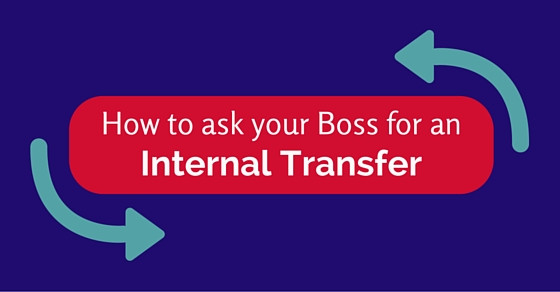
Bite-Sized tips to remember when requesting for an Internal Transfer
An internal transfer on the workplace.Best convincing ways to ask an internal transfer with the boss.

Have you been working under your boss for the past many years and feel like you need a change? Do you believe that there is a better job scope for you in a different department? Is there a different role in your firm that will allow you to evolve and grow? If answered yes to any of the queries above, then it’s time to request for an internal transfer.
What is an internal transfer?
An internal transfer may be a viable option when you want to continue working for the same company but in another department. There are other reasons you may opt for an internal transfer. They are-
- When you aren’t thrilled with your job but like your company.
- An internal transfer can be an excellent way to start a new career path when you want a change in your job function without having to seek employment with a new company.
- You can request for a transfer if you’re seeking to switch departments or want to work at a different job in the same company.
Sometimes, requesting for a transfer does not necessarily imply that you are unhappy with your current job position. Instead, a lateral move let you seek out promotions and diversify your portfolio. If you desperately want a change but don’t know where to begin, fret not! Here are five useful tips to follow when seeking for an internal transfer.
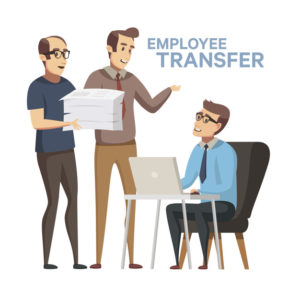
Five useful tips to follow when seeking for an internal transfer
- Do your homework
The first thing you should undoubtedly do before talking to your employer is to go through the company’s transfer policy. A lot of firms require employees to be in a position for a minimum number of years prior to requesting for a lateral transfer. So the last thing you should do is to request for a transfer before you meet this requirement, as that could easily backfire. You will end up with no chance of moving to a different team and stuck with an employer who knows you want to leave at some point.
Also, ensure to clarify the internal application process with your HR representative before having this delicate conversation with your employer. There is an immense difference between going to your boss with a well-thought-out plan and an unreasonable demand!
- Upgrade your resume
Once you have identified the positions available for internal transfer in your firm, it’s time to update your resume. Read through the job description in the available role thoroughly, identifying the important skills that the new department is expecting from the candidates. Then, list down your skills and expertise that match the new position. If you haven’t upgraded your resume in a long time, it would be a great idea to check and ensure your resume highlights your achievements. It increases your chances of landing your dream job.
Once you have updated your resume, make sure to identify the gaps between your skill set and the requirements for the new job. Come up with a strategic plan to achieve those skills in the next few months if possible. It let you close the gaps as much as possible before applying for the job role. Remember to highlight your plan to achieve the necessary competencies during your job interview. By doing this, you are showing your future boss not only that you care about your professional growth, but also that you are proactive.
- Brush up on your networking skills
When you want to seek out for an internal transfer, your networking skills should be sharp. You’ll never be able to understand the open position from the job description alone fully. So, talking to someone senior in the new department will help tremendously to understand the work culture and work expectations better. Make it a point to mingle with co-employers from different departments rather than just staying within your clique. This way, you can discover more about job vacancies and market your skills to potential employers informally before even heading for the interview!
- Make it clear that it’s not personal
The fact that you are requesting for an internal transfer doesn’t mean that you’re unhappy with your current employer, so make that clear! Explain to your manager why you are looking for this turn in your career. It will help to explain how you will add value to the new team with your technical experience. Ensure that you also articulate your gratitude for the expertise you have attained from your current team.
Even if you are requesting for an internal transfer because you are unhappy with the current boss, don’t apply to several openings within the same week. That just confirms that you’re despairing to jump ship. Instead, space out your applications and continue keeping your head down until you the transfer gets granted.
- Offer to train a replacement before leaving the role
When you request for an internal transfer, you are actually leaving your manager in a stressful point of finding a replacement for you in a short period. Now out of stress, they might, in turn, take it out on you. To keep a good relationship with your manager, even after you request for a lateral transfer, ensure to offer to make their life easier by training a replacement before leaving. Even if this lets you work extra hours to keep up with your pending assignments and the responsibility of training a replacement, it’s worth it as your employer would really admire your courtesy. There’s nothing awkward with requesting for a job transfer, just ensure to be aware of others’ feelings in the process.
Overall, requesting an internal transfer needs a level of tact, courtesy, and understanding of the process. Before you are ready to jump ship and dive into a new department, ensure, you follow these tips and prepare yourself.

How Businesses Should Handle the Coronavirus Outbreak

How Businesses Should Handle the Coronavirus pneumonia outbreak.Challenges for business in handling coronavirus epidemic or pandemic.

Corona – the deadly disease has arrived in many offices and employers around the world. The number is still increasing after every passing day. Around 93,526 coronavirus infection cases have been reported. It is far outpacing the SARS epidemic in the early 2000s. About 81 countries and territories around the world got affected, and 51,019 people only got recovered till now.
The daily reported cases outside of china have gone up considerably. Italy, South Korea and Iran are emerging as new hotbeds.
With coronavirus continuing to spread across the world, we have put together a handy guide. It is on the best practices companies, and human resources departments should follow to help their employees stay healthy and infection-free.
How Businesses Should Handle the Coronavirus Outbreak to ensure employees stay healthy and infection-free

- Effective Communication is Key
HR departments should pull together every information about the coronavirus to create a ready-to-refer instructional guide for employees. It not only educates them about the infection but also enlists the ideal ways to avoid it.
The communication strategy must be multi-pronged. You should use all channels of communication available to make the employees aware. You can use bulletin boards, stick posters on the wall, infographics, emails, videos, and any mode of media that could help to communicate the message to all employees effectively
The gathered information should only be from credible and verified sources. You can refer useful online pages, the CDC website, and reputable news outlets that attribute their knowledge to either statement made by governmental agencies, or health professionals engaged in the virus researching.
Execute Flexible Working Arrangement Plans or BCP Protocols. It is essential for the countries that share a border with China or have multiple reported cases of coronavirus infection. Allowing employees to work from home is a great way to prevent contamination, given that human-to-human transmission is possible.
By implementing flexible working arrangements, you can eliminate the possibility of transmission at the office and also during the commute. It is the best solution to help people in densely populated cities or packed urban areas to stay away from the disease. Employees can use chat platforms, project management dashboards and other platforms that are online or on the cloud.
It might not be possible for work that is location-dependent, though. Still, the CDC and WHO websites have laid out ways to avoid viral infections. They are implementing non-invasive approaches like face masks, alcohol-based hand sanitisers, and maintaining good personal hygiene.
- Reconsider employees Leave Policies
The last thing a company wants is an infected employee to turn up to work as they have no enough paid time off left. That not only hurts the sick worker who has to stress himself out to get to work, but also their colleague, as well as everyone and everything they encounter and touch on the way.
When a company is result-driven, no matter whether the employee work from home or in the office. You just need to ensure the work is getting delivered on time. As we have plenty of developments in today’s technology, there is a suite of solutions for companies to conduct meetings, discussions, and day-to-day work can go as usual.
For employees that are being sick, or start feeling ill during the day, especially those who are travelling, calling and notifying health authorities should be a priority. Fear mongering and forcing the sick employee into isolation, against their will, must be avoided at any costs until advised by the medical authority.
- Using technology to avoid human contact might not be a bad thing.
Platforms that let teams collaborate and communicate efficiently can be used during work-from-home days. Meetings can get done over Google Hangouts, Skype, or Zoom, while real-time collaborations can do using free platforms like Collabedit.
Other HR Initiatives, apart from providing free masks, and hand wash sanitisers, the cleaning schedule of the workspace can be increased.
- Senior management should make sure they mask up wherever appropriate to.
Temperature taking could be incorporated so that everyone in the workspace would have peace of mind and not be paranoid that their colleagues may get infected. Such information should be openly available so that workers have complete trust in the information provided.
Lastly, lunch could be catered to minimize employees’ exposure to crowded areas like the food centre.
The Corona crisis has now reached a new critical phase, and we need to take proper measures to take adequate care of ourselves and our family. Follow the above handy guide on best practices companies and human resources departments should deploy, and you’re your employees avoid exposure to the new virus strain.


Here are the eight questions employer should ask about coronavirus

What employer should ask about coronavirus. Fundamental question an employer should ask about coronavirus to ensure a safer workplace and the sanctuary of the employees.

The coronavirus outbreak originated in Wuhan, China. It has spread to at least 65 countries and sickened more than 89,000 people, with more than 3,000 deaths, as of March 2. Governments have closed their borders and imposed quarantines, and companies have banned travel. The human and economic impact on businesses has been stark.
This epidemic is the right moment for companies to review the strategies, policies and procedures carefully. They have to put them in place to protect employees, customers and operations for now and future epidemics. Here are eight questions that every employers should ask about coronavirus and respond to, the spread of the virus.

Eight questions that every employer should ask about coronavirus

- How can we protect our employees from the exposure?
The coronavirus that causes COVID-19 has thought to spread mainly through respiratory droplets produced from coughing and sneezing. It seems to spread quickly. It may also be possible to get infected by touching a contaminated surface or object and then touching one’s mouth or nose. The Centers for Disease Control and Prevention advises that employees should:
- Stay at home if they have respiratory symptoms (coughing, sneezing, shortness of breath) or a temperature above 100.4 degrees.
- Leave work if they develop any of these symptoms while at the workplace.
- You should shield coughs and sneezes only with a tissue, elbow or shoulder.
- Wash both your hands often with soap and water for a minimum of 20 seconds or use an alcohol-based hand sanitizer.
Since hand-washing is one of the most powerful defences, employers need to ensure that employees have ready access to washing facilities. And those should be kept well stocked with soap and paper towels. Alcohol-based hand sanitizers and sanitizing wipes should get distributed throughout the workplace. And all frequently touched surfaces, including work stations, countertops and doorknobs should be routinely cleaned.
- When should we exclude employees or visitors from the workplace?
As discussed above, employees should stay home or go home if they have symptoms of coronavirus infection. Managers should not hesitate to send workers who present with COVID-19 symptoms home. Besides, employees or visitors who are symptomatic or at high risk for COVID-19 should be kept separate from the regular staff. They must leave the workplace and obtain medical evaluation while minimizing their public exposure.
Public health organizations suggested that companies bar employees or visitors from coming to the workplace. It is essential for 14 days after a “medium” or “high-risk” exposure to the virus. It helps to avoid staying in close contact with someone who is known to be infected or having travelled from a high-risk region.
- Should we revise our benefits policies?
The number of employees unable to work is increasing. The reason is either because they are sick or because they must care for others. It means that it is the time companies should review their paid time off and sick leave policies. It will give employees confidence that they will not be penalized and can afford to take sick leave. It is an essential tool in encouraging self-reporting and reducing potential exposure.
While few firms outside of Asia have closed their worksites because of the epidemic. About half the Chinese companies had shut down worksites at least temporarily. Such closures will become more common outside of Asia if the epidemic continues on its current course.
- Have we maximised employees’ ability to work remotely?
Many jobs require employees to be physically present. But work including meetings can be done remotely should be encouraged if coming to work or travelling there risks exposure to the virus. For instance, videoconferencing is an excellent alternative to risky face-to-face meetings. Nearly 60% of the employers had increased employees’ flexibility for remote work (46%) or at least plan to (13%).
- Do we own reliable systems for real-time public health communication?
Dangerous rumours and worker fears can spread as quickly as a virus. Companies must reach all workers with regular, internally coordinated, factual updates about infection. You should make them aware of how to control the disease and its symptoms. Be clear with the company policy regarding remote work and circumstances. Let them aware of which employees might be excluded from or allowed to return to the workspace. The emergency response team should vet these communications. And they should be carefully organised to avoid inconsistent policies get communicated by different managers or functions. If you don’t have a current, universal contact capability already, now is an excellent time to create one.
- Should we revive our policies on international and domestic business travel?
Sixty-five per cent of companies are now restricting travel to and from Asia. It is essential to limit employee business travel from areas where COVID-19 is most prevalent. It can prevent both illnesses and avoid loss of productivity due to quarantine or employee exclusion from the workplace after the trip. Companies must track the CDC Travel Health Notices and the State Department Travel Advisories. It can determine what business travel should be cancelled or postponed. The CDC currently recommends that travellers avoid all nonessential trip to China, South Korea, Italy and Iran.
- Should we cancel or postpone scheduled conferences or meeting?
We have already seen scattered reports of cancelled in-person conferences and meetings. And we expect more reports in the upcoming months: 47% of employers are about to cancel planned meeting or conferences to North American employees in selected countries. Local health departments will declare guidance about whether events should be cancelled in a particular area. All conference organizers must provide information on diminishing the chance of infection. And they should assure that proper hand-washing facilities or hand sanitizers are readily available.
- Are supervisors adequately trained?
Sixty-five per cent of companies surveyed that have employees in China are training supervisors about the implications of COVID-19. And 34% of those with employees in North America report they are actively training or planning to train their managers. Whatever form the training takes, managers should have ready access to relevant information. And must know who to contact within the firm to report exposures. Managers or other designated persons in the company should promptly notify local health authorities about any suspected exposure.


Golden tips to provide quality feedback to your employees
Feedback to your employees is motivational to the employees. Analytical Feedback to your employees can be productive in the long run for good teamwork.

Feedback is something that can either make or break the performance of an employee. Almost every employee wants employee feedback, an honest assessment of their behaviour to help them improve their work. If an employee listens and takes action on, clear and constructive feedback, their overall performance will improve. It will not only result in Successful employee retention and promotion but also result in overall employee job satisfaction.
Not providing feedback can be detrimental. It can lead the employees two times more likely to be disengaged as they feel like their manager is ignoring them. So, it is crucial to ensure you communicate properly to your employees. Also, use this opportunity to cater to the development of your people.
- You should ensure that this feedback offers impact and makes a difference in your employees.
- How can you be sure to provide adequate feedback such as this?
The following tips will aid in this, so you can get started on developing your employees, and their performance, today!

How to feedback to your employees that get results

Be positive: Concentrate on what the person is doing to improve himself when you give feedback.
Focus on his behaviour, not the person: When you discuss a performance issue with any of your employees, keep your emotions in check. Focus on his actions, not the person.
Be specific: Provide solid examples of the behaviour in question. Do not ask vague, “drive-by” criticism like, “You have been arguing with clients a lot” or “I have heard several complaints about your attitude.”
Be timely: Don’t wait until the annual performance appraisal of the employee to provide positive or negative feedback. The closer feedback tie to the behaviour in question, the more powerful it will be.
Make sure you are very clear on why you are delivering the feedback: Feedback often arises from judgment, and we never want to pass it off as feedback. So, it’s critical to pause a moment and think about where the feedback is coming from and how can you deliver it to the employees in a way that he will receive positively.
Don’t consider judgment as a means for feedback: Never use feedback as a shield to share an actual criticism or be judgmental of another person. Judgment isn’t neutral. It is just your opinion on the character of a person.
Provide your feedback from a neutral place: Feedback is a piece of information or your observation, which you are sharing with your employee. Once a person gets the feedback from a neutral space, he can decide whether he should change or not.
Make it a two-way conversation: Take your time to engage your employee or team and check for understanding. Focus on “partnership,” not “this is what you’re doing wrong” or “this is what you need to change.”
Follow up: If your feedback concerns a problem, look for opportunities to “catch them doing it right.” Reinforce positive behaviour.
Make sure you have these qualities before delivering feedback: You can receive a Feedback in the best way when you establish authority, credibility and trust in a relationship. Without these things, it makes it more difficult to receive feedback.
Effective employee feedback is not one-size-fits-all. But, you can do a lot of things to make it a pleasant experience for everyone. Even the smallest gestures from you can make the biggest difference and help someone on their path to becoming a great worker.
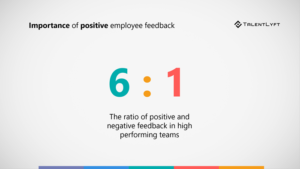
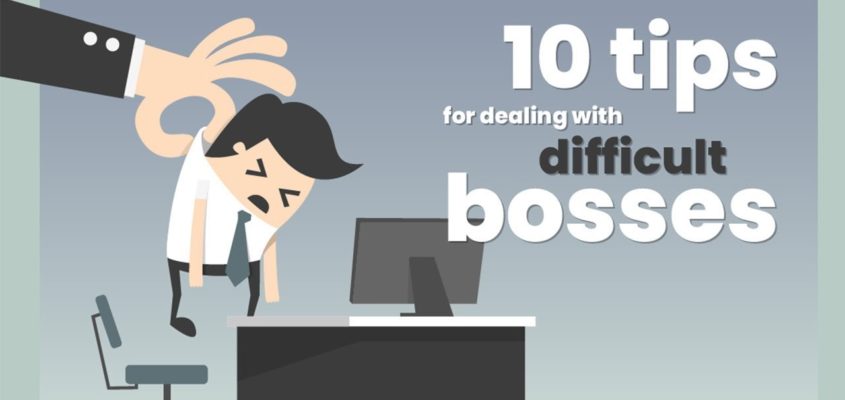
The actionable ways to work with difficult bosses
Work with difficult bosses is a tricky business.

Working for a boss who is competent, understanding, and supportive is excellent. But that isn’t the case always. Having the perfect boss is nearly impossible.
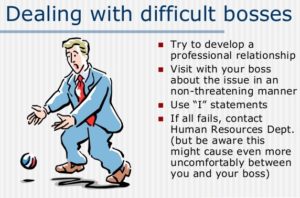
- Some bosses are just terrible,
- They are poor delegators and annoying micromanagers,
- Some of them are self-indulgently obsessed with the office gossip,
- They are only available on slack, where they consistently ignore your messages.
It’s critical to learn how to deal with the boss you have for your success. The best first step is to try to understand your boss and learn how to deal with their personality. There’s no doubt. Sometimes handling our bosses can be extremely difficult. In this blog, let us discuss a few common toxic bosses and the best ways to work with difficult bosses.
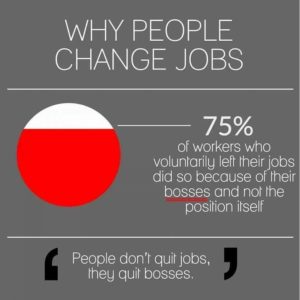
Common toxic bosses and the best ways to work with difficult bosses


- The Micromanager
The first and foremost kind of toxic boss is one who micromanages. They want to have input on every situation at every time. It’s not a personal attack on you or your work as the micromanager does this to everyone. They strive for perfection that can never get achieved.
How to Work With the Micromanager
There are several ways to deal with a micromanager. One way is to sit down with them and ask exactly what they want. This way, you can ensure you are clear about what they want, and you can both be on the same page. Fear of losing control is the reason why micromanagers exist. So, you should make them feel less fearful of entrusting tasks to you. It’s hard to get a micromanager to allow full freedom. Still, by getting them clearly, you should identify what they expect from you. When your boss sees you deliver the exact result, the working relationship will get better with time.
- The Dictator
Do you have a boss who tells you what all tasks to do, when to do them, and how to do them without allowing your input? This kind of bosses lives and breathes through his ego. They want power and want to be in charge. They also point fingers on you and want to intimidate you.
How to work with the Dictator
In this scenario, you must deal with your boss carefully. The goal is to avoid getting emotional or flustered. You have to be well calculated when dealing with a dictator boss. Let them have all the recognition. Since the ego of your boss leaves no room for yours, you have to get comfortable taking a back seat. Give them credit and trust that you did an excellent job. But be sure to keep a record of what you contribute, as this will be helpful in negotiations, and don’t release your value.
- The Inadequate One
It is the boss that made it through the ranks, and you don’t know, nor do they, how they got there. They are in over their head, and you have more knowledge and skills than they do, but they are at the top.
How to work with the Inadequate One
Don’t get frustrated. Just stop trying to highlight their incompetency. You know you have more knowledge than they do. You must let go of your pride and help elevate them because this will ultimately elevate you. Your boss will be so happy if you proceed to give them a helping hand, as this will make you both shine. Don’t try to hurt them; instead, help them out.
Though toxic bosses may be challenging, they are not impossible to work with. You can stop thinking that you can’t deal with them — because you can. You just have to know how to navigate through the situations, and these three tactics should help.


How to stop work life taking over your life?
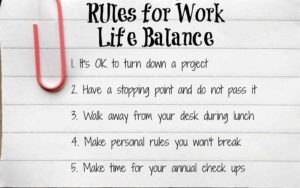
Work life taking over your life is a serious concern. Work life taking over your life has to get addressed with proper planning and accomplishment with honesty and devotedness.

“Don’t get so busy making a living that you forget to make a life.”
— Dolly Parton
We are living in an era were leaning in and working whatever hours it takes to get ahead in the profession. But in this race for career advancement, it can be increasingly easy to forget to take time for yourself. Most employees today find themselves with longer work hours and larger workloads. When you have more responsibilities, it’s hard not to let your career take precedence over everything in your life, which isn’t healthy.
Doing anything but work can seem like laziness or self-indulgence—especially when it looks like everyone else is still furiously working while you have taken off for the day. However, burnout is real. If you are not functioning at full capacity as you are mentally and physically exhausted, your work life and personal life will suffer.
The key is to obtain a good balance between your hard work and your outside life. Here are a few ways to ensure you have a healthy work and home life balance.
“Don’t confuse having a career with having a life.”
— Hillary Rodham Clinton

How to balance work life taking over your life?
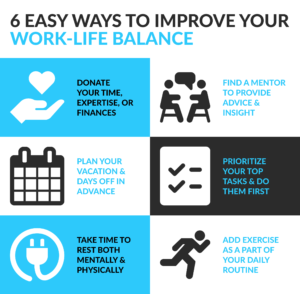
- Keep one-day meeting-free.
There are a lot of companies who establish one day a week as “meeting-free,”. In this day, no one is allowed to schedule any mandatory group gathering. If your firm doesn’t do this, suggest it to your employer. Setting aside one workday that’s just for you to work will do wonders for your productivity. You will get to finish your work during the day and take home less work and stress at night.
- Work from home if possible.
If you have an option of telecommuting at your job, take advantage of it. If it is not there yet, have a conversation with your boss. Even one day or half-day a week can help keep you grounded and give you a little bit of space extra that keeps you centred.
- Protect your time away from the office.
If you have to take work home, ensure you set strict time limits for yourself so that it doesn’t eat up all of your out-of-office time. Finish all the critical works. Respond only to the most important emails, then leave the rest for when you are back at your desk. And unless it is truly an emergency, try to make it a policy not to respond to work emails over the weekends. Your weekend time is your own.
- Fit in exercise.
Build your workday with simple exercises such as a half-hour walk during the lunch break. If that is not possible, adjust your weekly routine, and add one or two hours for exercise. Exercising will keep you fit, sharp, young, and full of endorphins. You can afford to find the time, so go ahead and ensure you do, your body and brain will thank you. Taking care of your body will take care of so much else.
- Make family your priority.
The people who love you and you love in your life aren’t replaceable, and your job should know that. So, show up if any emergencies come. Make some time to be there for the people you love as a rule, not as an exception.
- Take vacation.
Vacation and personal time exist for some reason. Take every day you are allowed. You are supposed to use these days, and you will be glad you did. Your work and attitude will undoubtedly improve after taking a short break.
- Schedule some blank time.
Rather than scheduling yourself to the gills, from your alarm turning off in the morning until bedtime, ensure you block off time in your schedule when you don’t have anything to do. Let your brain really and truly relax, and it will stay creative and sharp.
You may not be able to give yourself a full half-hour or one hour every day, but you can try it. Even just twenty minutes to sit calmly and meditate or take a brisk walk can make a difference in your attitude and your health.
“If you can’t do anything about it then let it go. Don’t be a prisoner to things you can’t change.”
— Tony Gaskinsl
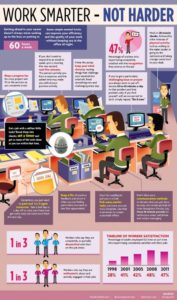
End of content
No more pages to load






